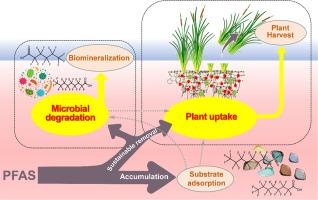当前位置:
X-MOL 学术
›
Water Res.
›
论文详情
Our official English website, www.x-mol.net, welcomes your
feedback! (Note: you will need to create a separate account there.)
Insights into poly-and perfluoroalkyl substances (PFAS) removal in treatment wetlands: Emphasizing the roles of wetland plants and microorganisms
Water Research ( IF 11.4 ) Pub Date : 2024-10-26 , DOI: 10.1016/j.watres.2024.122702 Changjie Zhao, Huaqing Liu, Dongle Cheng, Yanlong Wang, Zhen Hu, Haiming Wu, Huijun Xie, Jian Zhang
Water Research ( IF 11.4 ) Pub Date : 2024-10-26 , DOI: 10.1016/j.watres.2024.122702 Changjie Zhao, Huaqing Liu, Dongle Cheng, Yanlong Wang, Zhen Hu, Haiming Wu, Huijun Xie, Jian Zhang

|
Poly- and perfluoroalkyl substances (PFAS) are widespread emerging contaminants in aquatic environments, raising serious concerns due to their persistence and potential toxicity to both human health and ecosystems. Treatment wetlands (TWs) provide a sustainable, low-carbon solution for PFAS removal by harnessing the combined actions of substrates, plants, and microorganisms. This review evaluates the effectiveness of TWs in PFAS treatment, emphasizing their role as a post-treatment option for conventional wastewater treatment plants. Mass balance analysis reveals that substrate adsorption was the primary pathway for PFAS removal from TWs, while plant uptake and subsequent harvesting treatments, as well as microbial degradation, contribute substantially to long-term PFAS removal. Comparisons of bioaccumulation factor (BCF) and translocation factors (TF) between wetland and terrestrial plants demonstrate that wetland plants are particularly effective at adsorbing long-chain PFAS and transferring them from roots to aboveground tissues. The diverse environmental conditions within TWs support varied microbial communities, facilitating the evolution of PFAS-degrading microorganisms. Wetland microorganisms demonstrate the capacity to break down PFAS through processes such as head group transformations (e.g., decarboxylation, desulfonation) and defluorination (e.g., elimination, reductive defluorination, hydrolysis, dealkylation). This review emphasizes the crucial role of wetland plants and microorganisms in the sustainable removal of PFAS in TWs, providing insights for the ecological remediation of PFAS-contaminated wastewater.
中文翻译:

深入了解处理湿地中多氟烷基和全氟烷基物质 (PFAS) 的去除:强调湿地植物和微生物的作用
多氟烷基和全氟烷基物质 (PFAS) 是水生环境中广泛出现的污染物,由于其持久性和对人类健康和生态系统的潜在毒性而引起严重关注。处理湿地 (TW) 通过利用基质、植物和微生物的综合作用,为 PFAS 去除提供了一种可持续的低碳解决方案。本综述评估了 TW 在 PFAS 处理中的有效性,强调了它们作为传统废水处理厂后处理选择的作用。质量平衡分析表明,底物吸附是从 TW 中去除 PFAS 的主要途径,而植物吸收和随后的收获处理以及微生物降解对长期去除 PFAS 有很大贡献。湿地和陆生植物之间的生物积累因子 (BCF) 和易位因子 (TF) 的比较表明,湿地植物在吸附长链 PFAS 并将其从根部转移到地上组织方面特别有效。TW 内的不同环境条件支持不同的微生物群落,促进 PFAS 降解微生物的进化。湿地微生物通过头基转化(例如脱羧、脱磺化)和脱氟(例如消除、还原脱氟、水解、脱烷基化)等过程表现出分解 PFAS 的能力。本文强调了湿地植物和微生物在可持续去除 TWs 中 PFAS 的关键作用,为 PFAS 污染废水的生态修复提供了见解。
更新日期:2024-10-26
中文翻译:

深入了解处理湿地中多氟烷基和全氟烷基物质 (PFAS) 的去除:强调湿地植物和微生物的作用
多氟烷基和全氟烷基物质 (PFAS) 是水生环境中广泛出现的污染物,由于其持久性和对人类健康和生态系统的潜在毒性而引起严重关注。处理湿地 (TW) 通过利用基质、植物和微生物的综合作用,为 PFAS 去除提供了一种可持续的低碳解决方案。本综述评估了 TW 在 PFAS 处理中的有效性,强调了它们作为传统废水处理厂后处理选择的作用。质量平衡分析表明,底物吸附是从 TW 中去除 PFAS 的主要途径,而植物吸收和随后的收获处理以及微生物降解对长期去除 PFAS 有很大贡献。湿地和陆生植物之间的生物积累因子 (BCF) 和易位因子 (TF) 的比较表明,湿地植物在吸附长链 PFAS 并将其从根部转移到地上组织方面特别有效。TW 内的不同环境条件支持不同的微生物群落,促进 PFAS 降解微生物的进化。湿地微生物通过头基转化(例如脱羧、脱磺化)和脱氟(例如消除、还原脱氟、水解、脱烷基化)等过程表现出分解 PFAS 的能力。本文强调了湿地植物和微生物在可持续去除 TWs 中 PFAS 的关键作用,为 PFAS 污染废水的生态修复提供了见解。

































 京公网安备 11010802027423号
京公网安备 11010802027423号